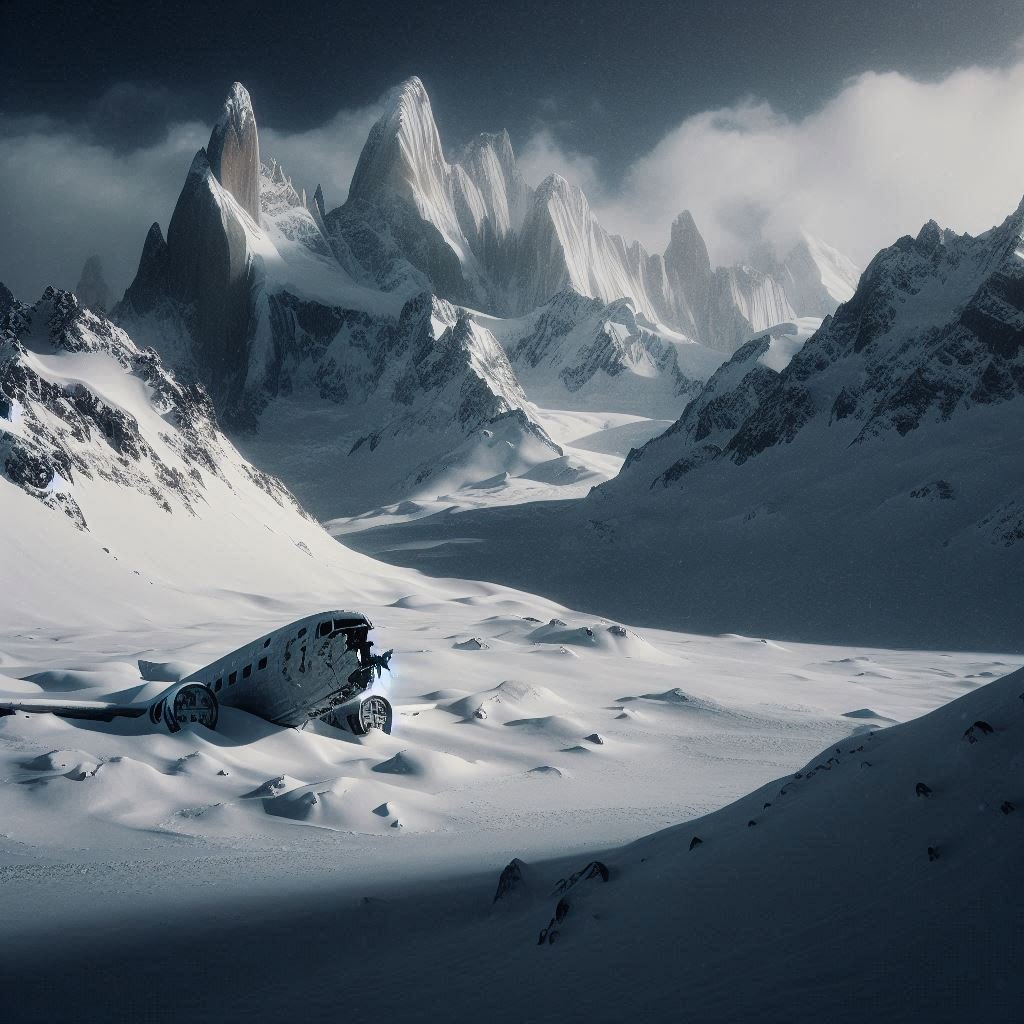Listen to “Andes Plane Crash” on Spreaker.
Picture this. A quiet morning, October 13th, 1972. A twin-engine Fairchild FH-227D plane cuts through the skies of South America. Onboard are 45 people—young men, a rugby team from Uruguay, their friends, family, and crew. They’re flying over the Andes Mountains on their way to Chile. Laughter fills the cabin. Jokes are shared. Nobody knows that in just a few hours, they will become part of one of the most terrifying survival stories in human history.
When the plane takes off, the passengers believe they’ll be landing in Santiago later that afternoon. Instead, they are about to crash into the heart of the Andes and face 72 days trapped in what survivors would later call “the white hell.”
The Flight That Should Have Been Easy
The team was the Old Christians Club, a group of amateur rugby players, many just in their late teens or early twenties. They weren’t soldiers or explorers. They were college kids. Some had never even been outside of Uruguay. Along with them were friends, relatives, and a small flight crew.
The weather was tricky. The Andes are one of the most dangerous mountain ranges in the world, stretching sky-high with jagged peaks. Clouds and turbulence often make flying there a nightmare. Still, the pilots were confident. The plan was simple: fly west, cut through the mountains, and land in Chile.
But as the plane approached the Andes, strong winds pushed them off course. Visibility dropped. The pilots thought they had already cleared the highest mountains when, in reality, they were still right in the middle of them. At 3:34 p.m., the worst happened.
The Crash
Out of nowhere, the plane’s right wing slammed into a mountain peak. The force ripped the wing clean off. Seconds later, the left wing tore away too. The fuselage—the body of the plane—shot forward like a bullet, bouncing and sliding down the snow-covered slope.
Inside, chaos exploded. Seats ripped from the floor. Passengers were thrown against each other. Screams filled the cabin as metal screamed louder. Finally, the fuselage skidded to a violent stop on a glacier at 12,000 feet.
When the dust settled, 33 of the 45 people were alive. Twelve had died instantly, including the team’s coach and several crew members. The survivors looked around. They were surrounded by endless white snow, towering mountains, and freezing winds. The temperature dropped to -30 degrees at night. And they were stranded with nothing but the wreckage.
The First Days in the White Hell
At first, hope kept them going. They believed search teams would find them quickly. After all, planes don’t just vanish. But the Andes aren’t kind. The fuselage was painted white, blending perfectly with the snow. From the air, it was invisible.
Rescue planes did fly overhead, but the survivors’ frantic shouts and mirror flashes went unseen. After eight days, the survivors heard a radio broadcast on a small handheld device they had salvaged. The news was devastating. The official search had been called off. They were presumed dead.
Imagine the silence that fell over them. They were 12,000 feet up, in freezing temperatures, with almost no food. No one was coming. If they were going to live, it was up to them.
Hunger, Desperation, and the Unthinkable
At first, they rationed what little food they had. Chocolate bars, a few bottles of wine, peanuts, and jam. But this didn’t last long. Hunger gnawed at them until it became unbearable. Their bodies grew weaker by the day.
Soon, there was only one option left—the unthinkable. The human body cannot survive more than a few weeks without protein. Surrounded by snow, the only source of food was horrifying. The bodies of their dead friends and teammates, frozen in the snow outside the fuselage.
The decision shattered them. These were people they had loved. But the choice was cruelly simple: eat or die. In the end, their survival instincts won. Several survivors would later describe it as the hardest thing they ever did. With tears in their eyes, they used shards of glass and broken metal to carefully cut thin strips of flesh.
The first bites were choked down with guilt and sorrow. But slowly, it kept them alive.
Avalanches and More Death
As if the crash and starvation weren’t enough, disaster struck again. On the seventeenth night, as they huddled in the fuselage for warmth, an avalanche thundered down the mountain. Snow poured through the broken walls and buried them alive.
Eight more people died that night, suffocated under the weight of the snow. Survivors clawed desperately with numb fingers to dig themselves out. When the storm cleared, only 19 remained.
The fuselage became both a shelter and a tomb. Bodies surrounded them, and the stench of death mixed with the freezing air. Every night was a fight against despair.
The Will to Survive
Despite the horror, a few men refused to give up. Chief among them was Nando Parrado, a 21-year-old rugby player who had been knocked unconscious during the crash. He had woken days later to learn his mother had died in the crash and his sister had died in his arms soon after. Nando could have given up. Instead, he became one of the strongest leaders among the survivors.
Nando and another player, Roberto Canessa, began planning something almost unthinkable: they would climb out of the Andes on foot to find help. But the mountains stretched endlessly in every direction. None of them were mountaineers. They had no maps, no climbing gear, and no idea where civilization even was. But they knew staying meant death.
The Trek for Life
On December 12th, 1972—two months after the crash—Nando, Roberto, and another survivor named Antonio set out. They wore layers of clothes made from seat covers, their shoes reinforced with stuffing from the wreckage. They carried makeshift sleeping bags sewn from insulation and a few strips of human flesh wrapped in cloth.
The journey was brutal. The mountains rose around them like walls of ice and stone. Each step sank into deep snow. Their lungs burned in the thin air. The sun blistered their faces by day, and the freezing cold nearly killed them by night.
After three days, Antonio was too weak to continue and turned back. But Nando and Roberto pushed on. For ten days, they marched, climbing ridges and sliding down icy slopes, their bodies pushed beyond the limits of human endurance.
Finally, they spotted something impossible—a green valley far below. Civilization. But it was still miles away, separated by rivers and cliffs. Nearly dead from exhaustion, they pressed on.
The Miracle Encounter
On the tenth day, Nando and Roberto stumbled upon a river where they saw something that looked like a miracle—three men on horseback across the water. Farmers. At first, the men thought the ragged figures were just mountain wanderers. But when they got close enough to hear their voices, the shocking truth became clear. These were survivors from the missing plane that had vanished 72 days earlier.
The farmers threw them bread, then rode for help. News spread like wildfire. A rescue operation was launched immediately.
Rescue at Last
On December 20th, helicopters cut through the sky above the Andes. They landed near the fuselage and found the survivors—gaunt, frostbitten, but alive. After 72 days in the white hell, 16 of the original 45 passengers were rescued.
The world was stunned. Newspapers called it “The Miracle of the Andes.” But when the truth about cannibalism came out, shock turned into controversy. Some people judged them harshly. Others defended them, saying no one could understand unless they had been there themselves.
The Legacy of the White Hell
Today, the story of the Andes crash is not just about tragedy. It is about the will to survive against impossible odds. Nando Parrado and Roberto Canessa, the two men who crossed the mountains, are still alive today. They’ve shared their story, not to glorify what happened, but to honor those who died and to show how strong the human spirit can be.
The crash site still exists, a frozen grave in the mountains. Climbers sometimes visit it, and some survivors have returned to honor their lost friends.
For the 16 who walked away, life was never the same. The white hell haunted them forever. But in that frozen nightmare, they proved something remarkable: that even when the world takes everything—warmth, food, hope—humans can still find the strength to fight for life.
When you hear this story, it feels impossible. A rugby team crashes in the middle of nowhere. Half die instantly. The rest face hunger, avalanches, and the cruelest choice a human being could ever face. Yet somehow, 16 walked out alive.
That’s the story of the Andes plane crash survivors. A story not just about death, but about what it truly means to cling to life when everything seems lost.




